
- #PARALLELS FOR MAC CANT TYPE FOR MAC OS X#
- #PARALLELS FOR MAC CANT TYPE MAC OS X#
- #PARALLELS FOR MAC CANT TYPE MAC OSX#
- #PARALLELS FOR MAC CANT TYPE SOFTWARE#
#PARALLELS FOR MAC CANT TYPE MAC OS X#
However, Parallels can be a great bridge between Windows and Mac OS X for users trying to switch platforms.
#PARALLELS FOR MAC CANT TYPE SOFTWARE#
The Mac hardware is significantly more expensive than comparable Windows PC systems, and would require an additional investment in the Parallels software as well as a legally-licensed copy of Windows. It seems like it should be technically possible given that both operating systems run on x86 architecture hardware, but doing so would be prohibitively frustrating, and would violate the Apple EULA for the Mac OS X software anyway.Īs a general user, the economics of using both operating systems simultaneously probably doesn’t make sense. You can’t run Mac OS X virtually from within Windows, but with Parallels you can run Windows virtually from within Mac OS X.

Windows, suffice it to say that each has its pros and cons, but that if you choose Mac OS X there are still some advantages to being able to shift gears into the Windows world if necessary. Without even getting into the religious debate about Mac v. Microsoft enjoys over 90 percent market share with Windows, while Mac claims only around five percent. While Apple has had some resurgent success with the Mac, the fact remains that it’s a Windows world. Parallels provides a virtual environment enabling Windows 7 to run from within Mac OS X.
#PARALLELS FOR MAC CANT TYPE FOR MAC OS X#
I had to change all of them accordingly.Parallels Desktop 6 for Mac OS X is coming soon, and it brings with it an array of improvements and new features that make it more possible than ever to straddle the line between Windows and Mac on the same hardware. Reload the project (R-click on unloaded project and then select "Reload Project").Īs an addition: As I had multiple run configurations, I also had multiple OutputPath entries.For instance, to set the path to the %TEMP%\UWPBuilds\x86\Debug directory Edit the path to an absolute path on one of VMs drives.For instance the entry for OutputPath when building for Debug|x86 should look likeīin/x86/Debug. Edit the project file in VS (R-click on unloaded project and then select "Edit.Unload the UWP project (R-click on project and then select "Unload Project".So the credit goes to the user JakubZ in the forum:įor further reference, the steps to resolve this issue are as follows: I had the same problem and found the following solution in the Parallels forum: Yes, as the error message shown, you've stored your project in the wrong place.


If you right click the iCloud on 'Mac'(X:), you will find that it is of type PrlSF. In Windows on Parallels Desktop > iCloud on 'Mac'(X:) > Documents > Visual Studio 2017 >. Windows can't deploy/debug your project because your project is stored in the file system of type PrlSF. Sorry about that if you can't read Chinese. But this time, make sure your project is stored in the C:\ in the Parallels Desktop(I mean that the location of your project start with C:\ ).Įxplain about the error message in the picture:įirst I want to say, I'm new to Visual Studio 2017, and I don't know why the language displayed in the Output contains Chinese, I've already changed it to English in the environment settings. You stored your project in the wrong place.ĭon't copy and paste your project directly to Windows10 in the Parallels Desktop.Ĭreate the project again. If your project is already stored in the C:\ of Windows10 in Parallels Desktop, go search other solution, I can't solve your problem, sorry.
#PARALLELS FOR MAC CANT TYPE MAC OSX#


 0 kommentar(er)
0 kommentar(er)
